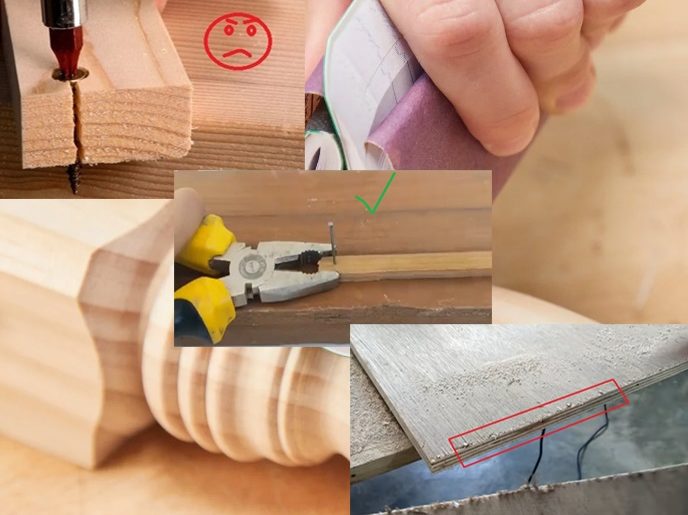One of the funniest things in woodworking is simple and innovative tricks that will save you time, money and more. These incredible tips will help you get your carpentry projects done faster and better than ever before. Stay with Wooddad to learn 9 Innovative woodworking tricks.
Flexible Sanding Block for Sanding Curved Wood Surfaces
A curved surface is a surface that is bent out. You had probably faced a lot of situations like this when making kinds of wooden projects. But not knowing how to sand curved surfaces can be a real headache for beginner woodworkers. So, How to Sand Curved Wood Surfaces?
Sometimes you need a sanding pad that’s both firm and flexible. Here, using a small notebook is a creative idea that works great. You must wrap sandpaper around the notebook and bend that to whatever arc you need.
Look at the image below. Give this a try the next time you’re working on a wood project that has curves.
Drive a Screw into the Hardwood
In some hardwood projects, the screw may sometimes not even get into the wood. You can use a little soap for this. Apply a little soap to the screw and then drive the screw into the wood. As simple as that!
Bobby Pin Nail Holder
It probably happened to you crushed your fingers when working with small nails. Such really bad pain it has! Here’s a very simple yet practical trick.
Hold a small nail with a bobby pin to avoid hammering your fingers. Look at the image below.
Lichtenberg Wood Burning eBook
Download Lichtenberg Wood Burning eBook
One of the modern techniques for creating wooden artwork is called Lichtenberg wood Burning. In this eBook, we are going to introduce this newfound art to you.
This technique is known with some different names such as Lichtenberg wood burning, fractal wood burning, and electricity wood art.
This technique should not be confused with wood burning art or pyrography. The art of pyrography on wood is the art of creating motifs and designs by burning with hot metal tools on objects such as wooden surfaces.
Lichtenberg burning is a wood-burning technique for creating designs with electricity.
This eBook is a comprehensive guide on Lichtenberg Wood Burning. All you need to know for Lichtenberg Wood Burning is here.
This is a limited-time offer, order now to get access to the future eBook releases.
A bobby pin is perfect because it can grip even the smallest nails and it provides plenty of distance between your fingers and the hammer.
Place the nail inside the bobby pin; then hold the bobby pin where you want. Once the nailing process started, you can remove the bobby pin and continue hammering. this is really a cool woodworking trick.
Drive Screws Without Splitting the Wood
Driving a screw directly into the wood, sometimes make the grain of the wood apart and softwoods will crush. On the other hand, hardwood is much more likely to simply split when the screw forces it.
As you can see in the below image, all kinds of woods will split when driving a screw.
When driving screws, drill a pilot hole to prevent the wood from splitting. The solution to this problem is simple. See the image below.
Drilling this pilot hole has two main advantages:
- It allows the threads of the screws to cut into the walls of the hole rather than forcing the wood fibers apart.
- This pilot hole will help the screw to drive in straight.
Wood Joints Without Nails, Screws, and Glue
Sometimes in some woodworking projects, you need to use nails or screws for connections. This woodworking trick is one of the most famous and important tricks in modern carpentry. In some of these joints, you can make strong connections without nails or glues. To know all of these joints, see wood joints without nails.
Sandpaper Cutter
A quick way to dull your scissors or utility knife blade is cutting sandpaper with them. Instead, you can fasten a hacksaw blade to the edge of your workbench. You can use it to cut sandpaper. See the image below.
Driving a Nail Without Splitting the Wood
When driving nails near edges or ends of hardwood or knotty wood, you may have the misfortune of having a large crack appear, or even a piece of your object break out at the edge.
There are many ways to prevent the likelihood of this happening. One of them is the use of hand clamps or hand pliers. Like the image below.
In this case, the chances of breaking the wood will be very low.
Darken Wood Without Commercial Stain
The wood stain does not just change the color of wood, but it also helps to protect the surface from the watermark, environmental damage and highlights the lovely natural grain of the wood.
Chemical and commercial stains are costly and some may even contain harmful ingredients like solvents and VOCs, so these are unsafe for the woodworkers, kids, and even pets.
The good news is that there are many ways to paint wood without commercial stain. See how to darken wood without commercial stain. This article shows you how to make wood paint from natural materials which can be found in your home.
A Cool Woodworking Trick When Sawing Wood
You may have encountered something like the picture below when sawing wood, especially plywood.
Do your best, but you can’t prevent small fractures at the cutting line. Of course, this problem happens more in plywood, engineered wood and when using saws that have large teeth.
The solution to this problem is to use paper adhesive tape. Just Paste the paper tape over the cut line before cutting.
Compare the results in the above images. This is really an innovative woodworking trick.

